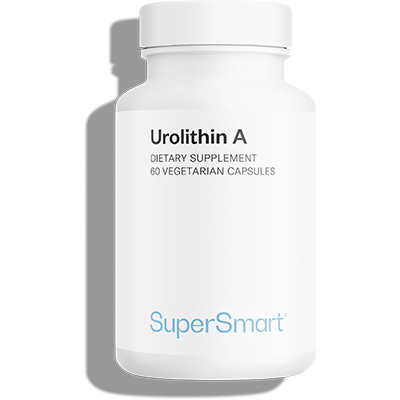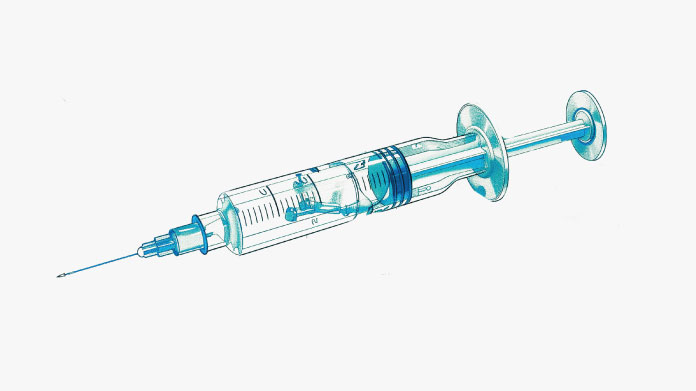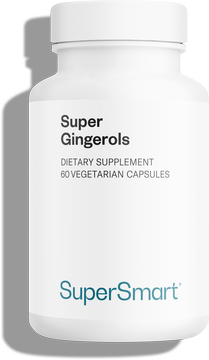Urolithin A: in which foods is this ‘anti-ageing’ molecule found?
Urolithin A is a rising star in anti-ageing research. But how exactly is this molecule thought to help combat ageing? And in which foods is it found?

What is urolithin A and what is the mechanism behind its huge potential?
Why all the excitement surrounding urolithin A?
The quest for cellular youth continues apace, and urolithin A may well be leading the pack.
Never has a molecule aroused so much enthusiasm in such a short space of time. It was identified by scientists during the 2000s and 2010s, as they strove to unlock the secrets of pomegranates’ health benefits.
They found that the molecule which appeared to best explain the fruit’s beneficial effects was not part of its nutritional composition.
This is because urolithin A is actually produced by gut flora in people who eat pomegranates!
It is formed by gut bacteria from the ellagitannins and ellagic acid found at high levels in the fruit’s seeds, juice and skin.
Urolithin A was quickly tested in C. elegans nematode worms where it was found to extend lifespan by 45%,, and then in elderly mice and rats where it restored real vigour during physical exertion.
In the process, researchers observed that urolithin A was the only molecule from pomegranates that could cross the blood-brain barrier.
This was enough to spark excitement among the scientific community: the studies increased, knowledge expanded and hopes gradually became convictions.
In July 2023, a meta-analysis pulled together 15 of the best studies on urolithin A, all published after 2019 (1). These studies consistently demonstrated the molecule’s potential against the effects of ageing in humans.
What is the mechanism at work in urolithin A?
Though further clarification is needed, the picture is becoming clearer regarding urolithin A.
Its production in the gut flora begins less than six hours after ingesting pomegranate juice (2), and is then detected in plasma – a sign of absorption in the colon – for several days.
What happens next? The latest studies suggest that urolithin A confers multiple potential effects on health: cardioprotective, prebiotic, antioxidant, anti-inflammatory and… anti-ageing!
Its presumed mechanism of action? Strengthening mitochondrial ‘quality control’ (an elimination and recycling process called ‘mitophagy’).
Mitochondria are highly dynamic cellular compounds, a kind of energy powerhouse, which play a fundamental role in every cell in the body: mitochondrial dysfunction is very often associated with age-related disorders (muscle wasting, metabolic problems, degeneration …) and accelerated ageing (3).
By helping to correct this dysfunction, urolithin A appears to have powerful anti-ageing effects.
What are the best dietary sources of urolithin A?
In actual fact, this is the wrong question since no food really contains urolithin A.
To boost your levels of this highly-promising molecule, you need to consume foods rich in ellagitannins (punicalagin, sanguiin H6, lambertianin C, pedunculagin, etc.) and ellagic acid.
These are the compounds which are converted into various types of urolithin (including A) in the colon, as a result of action by the microbiota (4-5).
Many fruits and vegetables contain free-form ellagitannins and ellagic acid, but the best sources are undoubtedly berries (raspberries, blackberries, redcurrants and strawberries) and certain nuts (pistachios, cashews, chestnuts, pecans) (6).
To a lesser extent, ellagitannins are also found in wines aged in oak barrels and seeds (to be consumed in moderation, of course).
Here are some of the best sources, in descending order of concentration:
- jaboticaba (Brazilian grape tree), 900mg/100g;
- walnuts (Juglans regia), 864mg/100g;
- raspberries, 326mg/100g;
- pecan nuts, 316mg/100g;
- cloudberries (Nordic berries), 312mg/100g;
- blackberries, 150-270mg/100g;
- chestnuts, 150mg/100g;
- pomegranates, 58-177mg/100g;
- strawberries, 71-83mg/100g;
- guava, 63mg/100g;
- grapes, 3-91mg/100g;
- Brazilian cherries (Eugenia brasiliensis), 16mg/100g.
Why are urolithin A supplements so invaluable?
Firstly, it has to be said that the best sources of ellagitannins and ellagic acid are not foods we eat every day.
Indeed research shows that daily intake is low: an average of 5mg a day in the West, and up to 12mg a day in summer in Scandinavian countries where berry consumption is high (7-8).
All of which makes it very appealing to be one of the first to try a urolithin A supplement (such as Urolithin A, tested for purity) in order to benefit at the earliest possible opportunity from this natural molecule with such high potential.
Especially since there’s another problem. Even though urolithin A can be produced by gut flora from foods rich in ellagitannins and ellagic acid, the efficacy of this conversion varies enormously between individuals (9).
Many people’s gut flora does not seem able to perform this conversion. Early research seems to indicate a low proportion of Coriobacteriia microorganisms within their microbiota, a family of bacteria thought to play a key role in the process.
It’s therefore entirely possible that you are unable to produce urolithin A without even realizing it.
Indeed, the conversion of ellagic acid into urolithin A may be possible in just 40% of the older population.
Either way, taking a pure urolithin A supplement means you can be sure you’re benefiting from significant amounts of the desired ‘end product’ itself - urolithin A (such is the case with the product Urolithin A, a pure, high-dose supplement produced from pomegranate).
SUPERSMART ADVICE
References
- Kothe B, Klein S, Petrosky SN. Urolithin A as a Potential Agent for Prevention of Age-Related Disease: A Scoping Review. 2023 Jul 27;15(7):e42550. doi: 10.7759/cureus.42550. PMID: 37637627; PMCID: PMC10460156.
- Seeram NP, Henning SM, Zhang Y, Suchard M, Li Z, Heber D. Pomegranate juice ellagitannin metabolites are present in human plasma and some persist in urine for up to 48 hours. J Nutr. 2006 Oct;136(10):2481-5. doi: 10.1093/jn/136.10.2481. PMID: 16988113.
- Mitophagy in degenerative joint diseases. Sun K, Jing X, Guo J, Yao X, Guo F. Autophagy. 2021;17:2082–2092.
- Espín JC, Larrosa M, García-Conesa MT, Tomás-Barberán F. Biological significance of urolithins, the gut microbial ellagic Acid-derived metabolites: the evidence so far. Evid Based Complement Alternat Med. 2013;2013:270418. doi: 10.1155/2013/270418. Epub 2013 May 28. PMID: 23781257; PMCID: PMC3679724.
- García-Villalba R, Beltrán D, Espín JC, Selma MV, Tomás-Barberán FA. Time course production of urolithins from ellagic acid by human gut microbiota. J Agric Food Chem. 2013 Sep 18;61(37):8797-806. doi: 10.1021/jf402498b. Epub 2013 Sep 6. PMID: 23984796
- Ortega Villalba Karen Johana, Vaillant Fabrice, Vélez Pasos Carlos, Rodríguez Pablo Emilio. 2020. Food ellagitannins: structure, metabolomic fate, and biological, properties. In : Tannins - Structural properties, biological properties and current knowledge. Aires Alfredo (ed.). Londres : IntechnOpen, 21-40. ISBN 978-1-78984-796-3
- Bakkalbasi E, Mentes O, Artik N. Food ellagitannins—Occurrence, effects of processing and storage. Critical Reviews in Food Science and Nutrition. 2009;49(3):283-298
- Bresciani L, Lean MEJ, Borges G, Calani L, Pereira-Caro G, Crozier A, et al. New insights into the bioavailability of red raspberry anthocyanins and ellagitannins. Free Radical Biology & Medicine. 2015;89:758-769. DOI: 10.1016/j. freeradbiomed.2015.10.400
- María Romo-Vaquero, Rocío García-Villalba, Antonio González-Sarrías, David Beltrán, Francisco A. Tomás-Barberán, Juan C. Espín, María V. Selma, Interindividual variability in the human metabolism of ellagic acid: Contribution of Gordonibacter to urolithin production, Journal of Functional Foods, Volume 17, 2015, Pages 785-791, ISSN 1756-4646.
4 Days
The products I use are excel·lent
The products I use are excel·lent
ROSAS Josep Maria
12 Days
Delivery is prompt and I never saw a…
Delivery is prompt and I never saw a quality problem with the manufacturing. It is not possible to assess efficacy on a personal basis, since too many factors come into play. Efficacy can only be assessed statistically with a sufficient number of cases.
Roger De Backer
13 Days
I collaborates with the Supersmart…
I collaborates with the Supersmart more than 10 years. Every thing is going good. Quality of the things is good. Delivery comes in time. Five stars definitely !!!
Oleksiy
13 Days
All good
Simple, frictionless site, easy ordering, good delivery updates and execution.
Chris Robbins
15 Days
I feel better
I feel better
Peter Ammann
15 Days
Prompt delivery
Prompt delivery
JAKUB Radisch
17 Days
My new go-to for top quality supplements!
I am buying more and more of my supplements from this superb, high quality company. Cannot recommend it enough. Plus, excellent customer service with a quick, helpful team and speedy deliveries. Highly recommend Supersmart!
Cecilie H.
20 Days
SUPERSMART WHAT ELSE👍
SUPERSMART WHAT ELSE👍
DIEDERLE Christophe
23 Days
Excellent quality products with…
Excellent quality products with innovative formulas, as someone who has been suffering with acid reflux, these supplements have been lifesavers.
Oriana Moniz
23 Days
high quality supplement!
high quality supplement!
GALANT
24 Days
Good service prompt delivery
Good service prompt delivery
Mrs Marcella Reeves
29 Days
I like your clear explanation
I like your clear explanation. And how to make a choice of products for a specific health problem
Ingrid
35 Days
Great product and it arrives quickly.
Great product and it arrives quickly.
SOMMARIVA Gianni
36 Days
Excellent products and fast service.
Excellent products and fast service. What do we need more?
Margarida
40 Days
The variety of products is amazing
The variety of products is amazing, the offers are good and the sending is very fast. I just miss having a bit more of guidance about combinations, possible interactions, etc.
Maria Angeles Verdu






